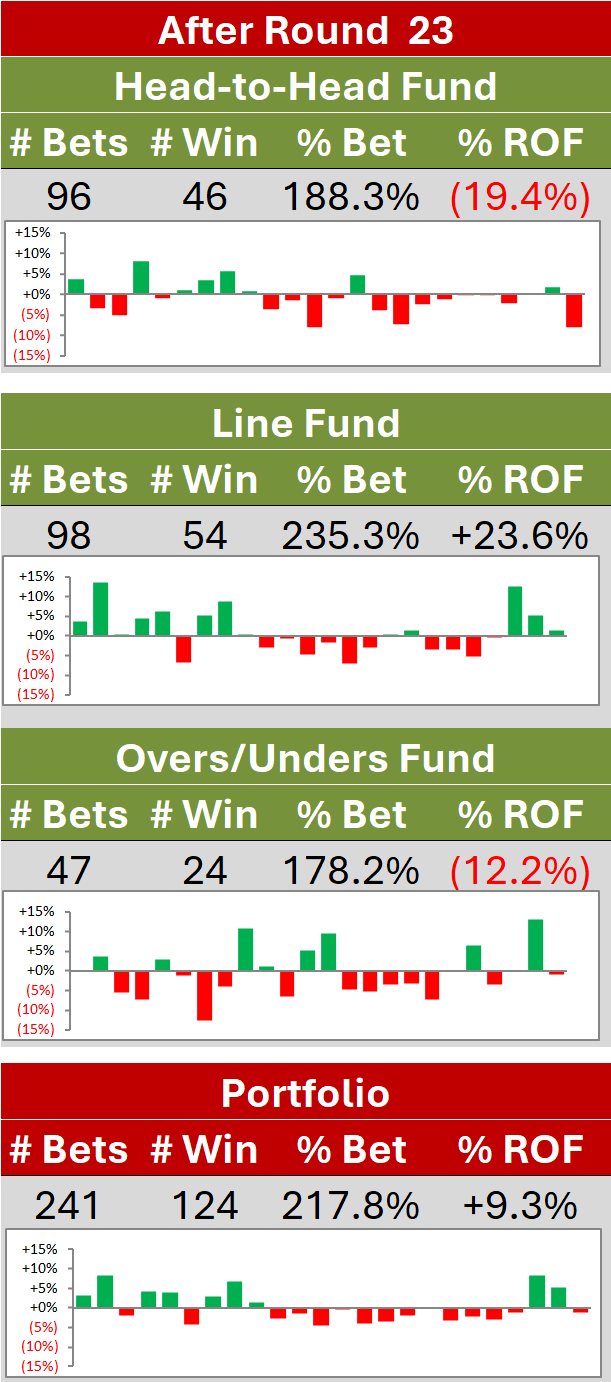2023 : Simulating the Final Ladder After Round 7
/There are now 11 teams with about 1-in-2 or better chances of playing Finals, six teams with about a 7-in-20 or better chances of finishing Top 4, and six teams with about a 1-in-14 or better chances of finishing as Minor Premiers.
Those simulations suggest that the teams can now be roughly grouped as follows:
Collingwood: roughly 95% chance of being a finalist; 75% chance of finishing Top 4; and 35% chance of being Minor Premier
Geelong, Melbourne, and Brisbane Lions: roughly 80 to 85% chance of being finalists; 50 to 55% chances of finishing Top 4; and 10 to 15% chances of being Minor Premier
Port Adelaide and St Kilda: roughly 70 to 75% chance of being finalists; 35% chance of finishing Top 4; and 7% chance of being Minor Premier
Carlton: 65% chance of being finalists; 25% chance of finishing Top 4; and 5% chance of being Minor Premier
Western Bulldogs, Adelaide, Essendon, and Sydney: 20% chance of being a finalist; 4% chance of finishing Top 4; and 1 to 2% chance of being Minor Premier
Gold Coast and Richmond: roughly 10 to 15% chance of being finalists; 1 to 2.5% chance of finishing Top 4; and little to virtually no chance of being Minor Premier
GWS and Fremantle: 5 to 7% chance of being a finalist; 0.5 to 1% chance of finishing Top 4; and virtually no chance of being Minor Premier
North Melbourne and West Coast: little to no chance of being finalists, finishing Top 4. or being Minor Premier
(For anyone who is curious about the precise methodology used for these simulations, please refer to this blog post over on the General Probability and Statistics journal)
LADDER FINISHES
The ladder projections using the Heretical outputs appear below.
We again see some quite large changes in Expected Win values for some teams - as much as +1.3 wins for Carlton, and -1.1 wins for West Coast.
The Blues and Power enjoyed the largest percentage point increases in their estimated finals chances, and the Swans, Tigers, and Saints suffered the largest declines.
The range of expected wins now runs from 4.8 to 17.0 (from 5.7 to 16.7 at the end of Round 6).
TEAM AND POSITION CONCENTRATION
The HHI figures for these pre-season simulation replicates appear below. These provide us with estimates of:
How many ladder positions a team is currently effectively fighting for
How many teams are currently effectively fighting for a given ladder position
HERETICAL METHODOLOGY
The new data reveals that Round 7 results reduced the uncertainty associated with each team and ladder position relative to Round 6 by about the same amount that the Round 6 results reduced the uncertainty relative to the end of Round 5. Over half of the teams are currently effectively fighting for between 10 and 13 ladder positions, and half the ladder positions have 11 to 13 teams effectively fighting for them.
On the teams side, those with least uncertainty remain West Coast, North Melbourne, Collingwood, and Hawthorn, and, on the ladder positions side, those with least uncertainty are still 1st, 16th, 17th, and 18th. That said, there are still effectively over five teams competing for the Minor Premiership, and over three for the spoon.
We see that the ladder positions with the most uncertainty remain those in the middle of the table, from about 5th to 12th.
We also see that the average team is effectively competing for 9.7 positions, and the average ladder position has about 9.8 teams competing for it.
WINS AND LADDER POSITION
The charts below investigate the relationships between ladder position and number of wins.
Firstly, we show the relationships by team, which illustrate the comments from the previous section about the teams with least uncertainty about their final home-and-away ladder finishes (viz West Coast, North Melbourne, Collingwood, and Hawthorn). Contrast the results for those teams with, say, those for Carlton and Western Bulldogs, which are the teams with the most uncertainty according to the HHI.
Next, we show the relationships after aggregating across teams.
Based on the simulations, we can say that:
For teams finishing 8th in a replicate: 18% had 12 wins (down 2%), 41% had 13 wins (up 2%), and 11% had 12.5 wins (down 1%)
For teams finishing 4th in a replicate: 34% had 15 wins (no change), 32% had 16 wins (up 1%), and 10% had 15.5 wins (no change). Also 6% had 14 wins (down 2%), and 5% had 14.5 wins (no change)
For teams finishing win 11 wins: 1% made Finals (down 1%)
For teams finishing win 12 wins: 20% made Finals (down 5%)
For teams finishing win 13 wins: 71% made Finals (down 3%)
For teams finishing win 14 wins: 97% made Finals (down 1%)
LIKELY IMPORTANCE OF PERCENTAGE
Next, we’ll use the simulations to investigate the estimated likelihood that any given pair of ladder positions will be determined after Round 24 based on percentage.
So, our new estimates are that:
There remains a slightly higher than 1-in-3 chance that 8th will be decided on percentages
There is a slightly higher than a 1-in-3 chance that 4th will be decided on percentages
There’s still about a 9-in-50 chance that 1st will be decided on percentages
FINALS CHANCES
Finally we take another look at team’s chances all the way through to the Grand Final, making reasonable assumptions about where Finals will be played given the participants and week of the Finals.
We have Collingwood now as slight favourites for the Flag at just over 1-in-5 chances, ahead of Geelong (1-in-5), Melbourne (2-in-15), Brisbane Lions (1-in-11), and St Kilda, Port Adelaide and Carlton (1-in-16).

